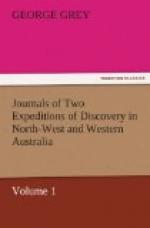When we had proceeded about a mile and a half from Santa Cruz I was astonished to hear, from the rocks on the shore, a loud roaring noise, and to see large clouds apparently of ascending smoke. I landed to ascertain the cause of this, and found it arose from one of those hollow rocks which are sometimes seen on our own coast and are known by various names, such as blowing stones, boiling kettles, etc. etc. I had however never seen one at all to be compared to this in size. It was formed by a hole in the rocks through which the water is first poured as the waves rush in; and then is partly driven out with a loud noise through a hole far up, and partly returns, in the form of spray, by the opening through which it was at first impelled. By assuming a proper position with regard to the sun a most beautiful rainbow is seen in this spray as it is dashed high into the air, and the whole is well worthy of a visit. Having collected some shells and geological specimens we again embarked for the cave.
On reaching the spot we distinctly observed, from the shore, the mouths of two caves full of bones. As the Guanches were in the habit of embalming their dead I entertained hopes of obtaining from them a mummy, of which there are several preserved in the Canary Islands. Upon landing however I found that they were utterly inaccessible, being situated in a perpendicular rock about 150 feet above the level of high water mark, and a considerable distance beneath the summit of the cliff. I had indulged a hope of being able to swing into one of the caves by means of a rope suspended from the top, but, owing to a large rock which projects from above quite over their mouths, this would be very difficult. Several bones had been blown out of the apertures, which I collected and found them to have belonged to man, but otherwise displaying nothing remarkable.
I can scarcely entertain a doubt but these caves really were the burying-places of the ancient Guanches, yet how they were approached I cannot conceive; probably there might have been an entrance to them from the interior of the country. I searched but my time was short and I could find no traces of such. An interesting question here remains to be solved and I trust some future traveller may be induced to attempt it.
There is only one other supposition I could frame on this subject, and to this I am led from the fact of the bones lying so immediately in the caves’ mouths. Could a party of the Guanches, when so oppressed and so cruelly treated by the Spaniards, have taken refuge by some means in these caverns, and afterwards, from their retreat being cut off, have found themselves unable to escape and have here perished miserably; looking out of the cavern to the last for that assistance they were never doomed to receive? If they had managed to enter these caves by a narrow pathway running along the face of the cliffs, which the Spaniards afterwards destroyed, such an occurrence might readily have taken place.




